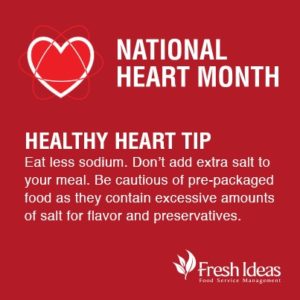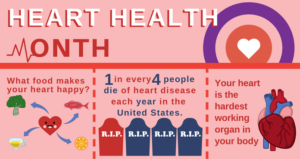Cardiac rehabilitation, also called cardiac rehab, is a customized outpatient program of exercise and education. Cardiac rehabilitation is designed to help you improve your health and help you recover from a heart attack, other forms of heart disease or surgery to treat heart disease.
Cardiac rehabilitation week this year 2021 is February 14th through the 20th.
Cardiac rehabilitation often involves exercise training, emotional support and education about lifestyle changes to reduce your heart disease risk, such as eating a heart-healthy diet, keeping a healthy weight and quitting smoking.
The goals of cardiac rehabilitation include establishing an individualized plan to help you regain strength, preventing your condition from worsening, reducing your risk of future heart problems,C and improving your health and quality of life.
Research has found that cardiac rehabilitation programs can reduce your risk of death from heart disease and reduce your risk of future heart problems. The American Heart Association and American College of Cardiology recommend cardiac rehabilitation programs.
Why is this rehab. done?
Cardiac rehabilitation is an option for people with many forms of heart disease. In particular, you may benefit from cardiac rehabilitation if your medical history includes:
Heart attack/Coronary artery disease/Heart failure/Peripheral artery disease/Chest pain (angina)/Cardiomyopathy/Certain congenital heart diseases/Coronary artery bypass surgery/Angioplasty and stents/Heart or lung transplant/Heart valve repair or replacement/Pulmonary hypertension.
Don’t let your age hold you back from joining a cardiac rehabilitation program. People of all ages can benefit from cardiac rehabilitation.
Cardiac rehabilitation isn’t appropriate for everyone who has had heart disease. Your health care team will evaluate your health, including reviewing your medical history, conducting a physical examination and performing tests, to make sure you’re ready to start a cardiac rehabilitation program.
Rarely, some people suffer injuries, such as strained muscles or sprains, while exercising as a part of cardiac rehabilitation. Your health care team will carefully monitor you while you exercise to lower this risk and will teach you how to avoid injuries when you exercise on your own. There is also a small risk of cardiovascular complications.
During cardiac rehabilitation
The first stages of most cardiac rehabilitation programs generally last about three months, but some people may be in programs for a longer period. In special situations, people may be able to do an intensive program that may last one or two weeks, several hours a day. During cardiac rehabilitation, you’ll likely work with a team of health care professionals, which may include cardiologists, nurse educators, nutrition specialists, exercise specialists, mental health specialists, and physical and occupational therapists.
Cardiac rehabilitation includes:
- Medical evaluation. Your health care team will generally perform an initial evaluation to check your physical abilities, medical limitations and other conditions you may have. Ongoing evaluations can help your health care team keep track of your progress over time.During your evaluation, your health care team may look at your risk factors for heart complications, particularly during exercise. This can help your team tailor a cardiac rehabilitation program to meet your individual needs, and the team can make sure it’s safe and effective for you.
- Physical activity. Cardiac rehabilitation can improve your cardiovascular fitness through physical activity. Your health care team will likely suggest low impact activities that have a lower risk of injury, such as walking, cycling, rowing, jogging and other activities. You’ll usually exercise at least three times a week. Your health care team will likely teach you proper exercise techniques, such as warming up and cooling down.You may also do muscle-strengthening exercises, such as lifting weights or other resistance training exercises, two or three times a week to increase your muscular fitness.Don’t worry if you’ve never exercised before. Your health care team can make sure the program moves at a comfortable pace and is safe for you.
- Lifestyle education. You’ll usually receive support and education on making healthy lifestyle changes, such as eating a heart-healthy diet, exercising regularly, maintaining a healthy weight and quitting smoking.Your health care team may give you guidance about managing conditions such as high blood pressure, diabetes and high cholesterol.You’ll likely have opportunities to ask questions about such issues as sexual activity. You’ll also need to continue taking any medications you’ve been prescribed by your doctor.
- Support. Adjusting to a serious health problem often takes time. You may feel depressed or anxious, lose touch with your social support system, or have to stop working for several weeks.If you get depressed, don’t ignore it. Depression can make your cardiac rehab program more difficult, and it can impact your relationships and other areas of your life and health.Counseling can help you learn healthy ways to cope with depression and other feelings. Your doctor may also suggest medications such as antidepressants. Vocational or occupational therapy can teach you new skills to help you return to work.
Although it may be difficult to start a cardiac rehabilitation program when you’re not feeling well, you can benefit in the long run. Cardiac rehabilitation can guide you through fear and anxiety as you return to an active lifestyle with more motivation and energy to do the things you enjoy.
Cardiac rehabilitation can help you rebuild your life, both physically and emotionally. As you get stronger and learn how to manage your condition, you’ll likely return to a normal routine, along with your new diet and exercise habits.
It’s important to know that your chances of having a successful cardiac rehabilitation program rest largely with you. The more dedicated you are to following your program’s recommendations, the better you’ll do.
After cardiac rehabilitation
After your cardiac rehabilitation program ends, you’ll generally need to continue the diet, exercise and other healthy lifestyle habits you learned for the rest of your life to maintain heart-health benefits. The goal is that at the end of the program you’re confident to exercise on your own and you’re empowered to maintain a healthier lifestyle.
Results
Cardiac rehabilitation is a long-term maintenance program, and you’ll generally need to continue the habits and follow the skills you learned in the program for the rest of your life. After about three months, you likely will have developed your own exercise routine at home or at a local gym.
You may also continue to exercise at a cardiac rehab center, a fitness center or a club. You may also exercise with friends or family. You may remain under medical supervision during this time, particularly if you have special health concerns.
Education about nutrition, lifestyle and healthy weight may continue, as well as counseling. To get the most benefits from cardiac rehabilitation, make sure your exercise and lifestyle practices become lifelong habits.
Over the long term, you may:
- Gain strength
- Learn heart-healthy behaviors, such as regular exercise and a heart-healthy diet
- Cut bad habits, such as smoking
- Manage your weight
- Find ways to manage stress
- Learn how to cope with heart disease
- Decrease your risk of coronary artery disease and other heart conditions


